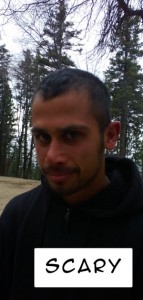In a game of tag with 12 year old boys, one of my students picks up a stick and tries to “tag” another child with it. I stop them all with a “freeze” command put in place before the game started and try to explain why tagging people with sticks is a very bad idea.
 My name is Ian and I am an instructor here at High Trails in Southern California. I have also spent time working with children of all ages in different countries such as Ghana, Gambia and Peru. This raises the question: do children act differently in different places?
My name is Ian and I am an instructor here at High Trails in Southern California. I have also spent time working with children of all ages in different countries such as Ghana, Gambia and Peru. This raises the question: do children act differently in different places?
Take my example above; I have seen both students from Peru and Southern California make the same mistake in games of tag after I explained, before we began, that they were not to pick up sticks. Both were groups of 12 year old boys but were raised in completely different environments, different countries. Young boys will always pick up sticks, and sometimes that desire doesn’t end when they enter adulthood. As an outdoor educator I still want to pick up sticks and rocks every time I sit through an inservice. It’s a natural instinct for us (especially us boys) to to pick things up off the ground. So, while there may be differences in children from different countries, there are also many similiarities. Sometimes, boys will be boys.
 I have often been asked about dealing with children from different countries, or reprimanding a student when there is a clear language barrier between the child and myself. This raises the next question: what if I can’t communicate effectively with words?
I have often been asked about dealing with children from different countries, or reprimanding a student when there is a clear language barrier between the child and myself. This raises the next question: what if I can’t communicate effectively with words?
One of the greatest things I have been taught here at High Trails is how I don’t have to be completely reliant upon language to get my point across. Whether you’re a mother in Gambia speaking Wolof, or a mother from Southern California Speaking English, both mothers have the “eye”; the ability to look at a child and effectively let them know that what they are doing is wrong and they need to stop without actually saying anything.
In addition to the “eye”, I also occasionally use as a simple light touch on the student’s shoulder or I walk over and stand right next to them. All of these methods inform them that they are doing something inappropriate and asks them to change their behavior without my having to actually say anything.
 As an educator I find my ability to interact and communicate with students doesn’t stop just with those that know my language or are from the same place as me. I use the same classroom management techniques teaching English in Peru, volunteering at an orphanage in Ghana, and teaching science at High Trails.
As an educator I find my ability to interact and communicate with students doesn’t stop just with those that know my language or are from the same place as me. I use the same classroom management techniques teaching English in Peru, volunteering at an orphanage in Ghana, and teaching science at High Trails.
I can connect with kids without words: through my ability to juggle, make silly faces, play sports, draw in the dirt, or eat ants together. All of these things help me work with and relate to students , whether they are from the other end of the world or live just down the hill from me in Los Angeles, California.
At High Trails Outdoor Science School, we literally force our instructors to write about elementary outdoor education, teaching outside, learning outside, our dirty classroom (the forest…gosh), environmental science, outdoor science, and all other tree hugging student and kid loving things that keep us engaged, passionate, driven, loving our job, digging our life, and spreading the word to anyone whose attention we can hold for long enough to actually make it through reading this entire sentence. Whew…. www.dirtyclassroom.com

Comments are closed.